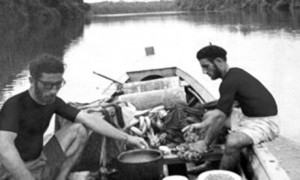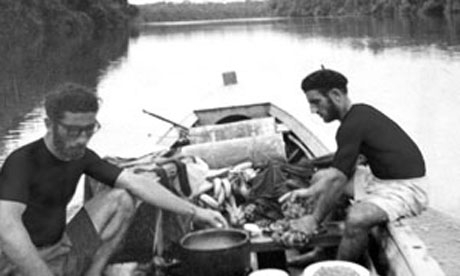 In the 1950s, the Omidvar brothers travelled the Congo, the Arctic and the Andes on motorbikes and in a 2CV. The recently rediscovered film of their trip will be shown at next month's Adventure Travel Film Festival.
In the 1950s, the Omidvar brothers travelled the Congo, the Arctic and the Andes on motorbikes and in a 2CV. The recently rediscovered film of their trip will be shown at next month's Adventure Travel Film Festival.It would take a brave soul to set out today on a 10-year journey around the world on a motorbike, a journey that deliberately passed through places that include Congo, the Arctic Circle and the entire length of the Andes. That is exactly what the Omidvar brothers from Tehran did back in 1954. Throwing their film-making kit on their bikes and with just $90 each to spend, they set out to see the most remote people they could possibly find. En route they created a visual record that is now a milestone in film history, a documentary record of a vanished world: peoples, cultures and even entire countries that no longer exist.
Heading east they first passed through Pakistan, India, south-east Asia and Australia, eventually crossing the Pacific and heading up through Alaska and Canada into the Arctic. A vast sweep all across and down the Americas ended with a trip to Antarctica then, after a brief trip home, a new round of exploration in a 2CV, which they drove through Africa, somehow managing to get the vehicle through the Congo and the formidable barrier of the Ituri forest.
The films they made along the way are full of the wonder and excitement of exploration. They also bring an interesting counterpoint to a visual media that was, at the time, dominated by America and Europe. While the rest of the world was racing to modernity and feeling smugly superior to so-called primitive peoples, Abdullah and Issa Omidvar had an easy affinity and respect for those they met, something that gave them unique access to sights and sounds that were soon to be lost. What we also see is a world in a far better condition than might be imagined: forests seem endless, remote people seem happier and more secure in their lives; it is a world before globalisation, and a place cleaner and far less hectic.
When their journeys ended, Abdullah settled in Chile, founding a successful film company and cinema, while Issa returned to�Iran�as something of a celebrity. There in Tehran, in an 18th-century Pahlavi palace, he built a museum to house all the artefacts that he and his brother had collected. It's a place very much worth a visit (Omidvar Brothers Museum).
It is the films, however, that are the most significant artefacts. At a moment in history when many Iranians want to end their country's isolation, it seems appropriate to watch these two intrepid explorers embark on a journey that became a marathon celebration of how humanity can defeat its tendency towards fear of outsiders and foreigners. That, after all, is when travel is at its best.
The best bit of my job is the detective work involved in digging up weird and wonderful archive footage. Over the years we've screened films of�a 1950s Land Rover expedition to the Far East, the�first women to motorcycle through Africa in 1934, and the�underground 1971 psychedelic road movie Cycles South. But for me, the most exciting find of all has to be the film of the Omidvar brothers' 10-year expedition around the globe in the 1950s and 60s. Discovering a lost film like this is akin to finding that rare record you didn't even know existed.
I came across the Omidvar Brothers by accident while writing an article for a US travel magazine about historic overland expeditions. After wading through vast amounts of research, I found myself on an obscure German website. My eye was caught by a black-and-white photo of two dashing young men on classic British motorcycles. Some further digging revealed their identities as Iranian brothers Issa and Abdullah Omidvar. Getting hold of this film became an obsession and after many favours from Farsi-speaking friends in London, contact was made with Issa and a DVD eventually arrived in the post from Tehran.
In keeping with the down-home, have-a-go ethos of the Adventure Travel Film Festival, the Omidvars were not seasoned travellers, professional film-makers or members of the elite. They were two men in their early 20s who wanted to learn more about the world. But, most significantly, they were not European. By the mid-1950s the writing was on the wall for heavy-handed European colonialism and the Omidvars' open, gentle approach � summed up in their motto attached to their bikes "All different, all relative" � was clearly a great asset to their explorations. Although the brothers refer to themselves as "white-skinned" in their narration, it was only in South Africa that they encountered any discrimination. "We were rejected by the white population of South Africa because of our Asian origins," says Issa, "and the black population avoided us because of our white skin." But from the point of view of a curator who ploughs through films made almost exclusively by westerners, their Iranian outlook is a refreshing and welcome variation.
These days, the Omidvars have slipped off the radar, even in their homeland, although there are some Iranians who remember their adventures being broadcast as a weekly TV show in the late 1960s. Ooshin Nabijou, a lecturer at London Metropolitan University grew up in Tehran and recalls watching the series as a nine-year old with his father. He hopes that one day the Omidvars will be recognised as the great Iranian explorers that they were: "Iran does not preserve its heritage and history in the same way as in Europe," says Nabijou, "but that is changing and Iranians are becoming aware of their own icons." Hopefully this UK premiere of their film will help the Omidvar Brothers finally achieve the recognition they deserve.
By The Guardian
The Iran Project is not responsible for the content of quoted articles.











